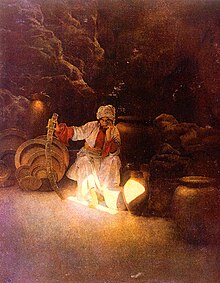Arabic epic literature

Arabic epic literature encompasses
Popular epic
In the 13th century, an Arabic epic poem entitled Antar was created based on
Fantasy epic literature

The
The stories of
The Thousand and One Nights is usually placed in the genre of Arabic epic literature along with several other works. They are usually, like the Tales, collections of short stories or episodes strung together into a long tale. The extant versions were mostly written down relatively late on, after the 14th century, although many were undoubtedly collected earlier and many of the original stories are probably pre-Islamic. Types of stories in these collections include
The epic took form in the 10th century and reached its final form by the 14th century; the number and type of tales have varied from one manuscript to another.[3] All Arabian fantasy tales were often called "Arabian Nights" when translated into English, regardless of whether they appeared in The Book of One Thousand and One Nights, in any version, and a number of tales are known in Europe as "Arabian Nights" despite existing in no Arabic manuscript.[3]
This epic has been influential in the West since it was translated in the 18th century, first by
Arabian Nights was not the only Fantasy story that exist in Arabic epic literature. Arabic short stories scripts was discovered in 1933 when
Science fiction
| Part of a series on |
| Arabic culture |
|---|
 |
Al-Risalah al-Kamiliyyah fil Siera al-Nabawiyyah (The Treatise of Kamil on the Prophet's Biography), known in
A number of
Other examples of early Arabic proto-science fiction include
List
Here is a list of famous
- One Thousand and One Nights (Arabian Nights)
- Sirat Antara Ibn Shaddadسيرة عنترة بن شداد
- Sirat al-Zahir Baibarsسيرة الظاهر بيبرس
- Sirat Bani Hilal تغريبة بني هلال
- Sirat Sayf Ibn Dhi Yazanسيرة سيف بن ذي يزن
- Sirat Dhat al-Himma, Arabic queen tale سيرة ذات الهمة
- Sirat prince Hamza al-Bahlawn سيرة الأمير حمزة البهلوان
- Sirat Ali al-Zaibak سيرة علي الزيبق
- Sirat Sayf al-Tijan سيرة سيف التيجان
- al-Sirah al-Hussainyya. السيرة الحسينية
- Mal'abat Al-Kafif az-Zarhuni ملعبة الكفيف الزرهوني
- The Tale of Al-Shater Hassan قصة الشاطر حسن
- The Tale of Zir Salimقصة الزير سالم
- The Tale of King Luqman bin Aad قصة الملك لقمان بن عاد, According to the Tale He is the brother of Shaddad bin Aad
- Layla and Majnun in Arabic Majnun layla (مجنون ليلى) romantic epic (also known as Qays wa Laila, "Qays & Laila").
- Arab-Andalusian love story about Bayad, a merchant's son and a foreigner from Damascus, for Riyad, a well-educated slave girl in the court of an unnamed Hajib(vizier or minister) and his daughter.
- Tarikhul Hind wal Sindتاريخ الهند والسند
- Futuh al-Sham (Conquests of Syria) ascribed to al-Waqidi (disputed)
See also
- Arabic literature
- Alwah, a journal of Arabic literature
References
- ^ Pouillon, Francois (1997) Les deux vies d'Étienne Dinet, peintre en Islam: L'Algerie et l'heritage colonial Editions Balland, Paris;
- ISBN 0-7043-2162-9
- ^ ISBN 0-312-19869-8
- ISBN 0-87054-076-9
- ^ ISBN 0-312-19869-8
- ISBN 0-380-86553-X
- ^ a b c d Irwin, Robert. "The earliest known Arabic short stories in the world have just been translated into English for the first time". INDEPENDENT. Retrieved 24 August 2018.
- ^ a b Lowry, Elizabeth. "Tales of the Marvellous and News of the Strange review – a medieval Fifty Shades of Grey?". The Guardian. Retrieved 24 August 2018.
- ^ I. Heullant-Donat and M.-A. Polo de Beaulieu, "Histoire d'une traduction," in Le Livre de l'échelle de Mahomet, Latin edition and French translation by Gisèle Besson and Michèle Brossard-Dandré, Collection Lettres Gothiques, Le Livre de Poche, 1991, p. 22 with note 37.
- ^ Dr. Abu Shadi Al-Roubi (1982), "Ibn al-Nafis as a philosopher", Symposium on Ibn al-Nafis, Second International Conference on Islamic Medicine: Islamic Medical Organization, Kuwait (cf. Ibnul-Nafees As a Philosopher, Encyclopedia of Islamic World [1])
- ^ ISBN 1-86064-983-1
- ISBN 1-86064-983-1
- ISBN 1-86064-983-1
- ISBN 90-04-09530-6
- ISBN 1-86064-983-1
- ^ ISBN 90-04-09530-6
- ISBN 0-19-275013-5
- ^ Academic Literature, Islam and Science Fiction
- ^ Achmed A. W. Khammas, Science Fiction in Arabic Literature
External links
- Al Jazeera article: Epic tales of Arab bravery (archived 16 December 2005)
